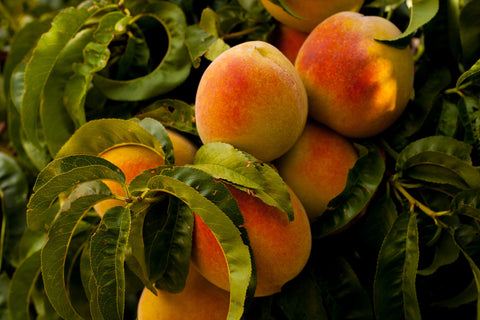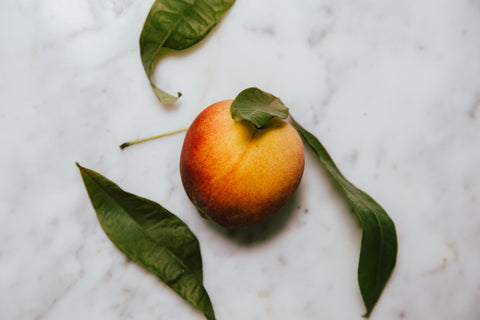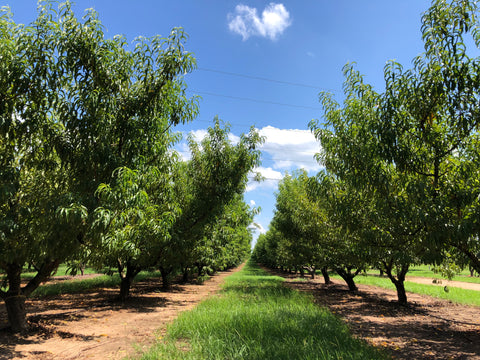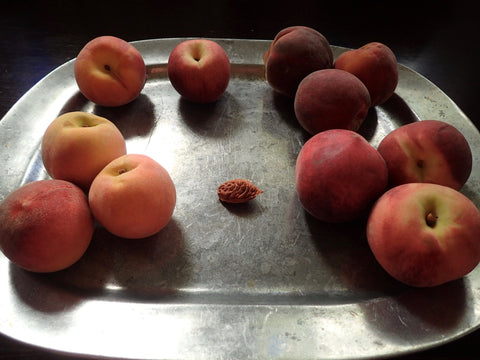A Story of Peaches
The golden hues of a ripe, succulent peach make even the most cynical person smile. "Wow, this is a good peach," as they forget their complaints and take a few minutes to enjoy the divine work of nature. Truth, the peaches in my backyard make me mad. Well, the squirrels eating all of my peaches off the tree make me go crazy while the cats laze around without concern. Welcome to the long sunny days of summer.

Peaches are the herald of summer reaching their ideal ripeness around the solstice. The markets are flooded with peaches and their copycat cousin, nectarines, from June to August. One of the few fruits to remain seasonal, peaches are revered as an icon of the South but are actually one of the oldest cultivated fruits. Inside each fleshy fruit is a seed or stone that can be easily transported. The botanical name, Prunus persica, is significant due to its early believed origin from Persia to Europe, however, peaches are native to China. Today, over half of the global peach harvest is produced in China.

Peaches are the fruit of immortality in Chinese legend. Today the fruit is a symbol of longevity.
The pits of peaches were brought to the New World with the early Spanish explorers and planted near the missions in Florida. It is a long-held belief that the Cherokee Indians were the first to cultivate peaches in the New World spreading the seeds throughout the southeast. In the temperate regions like South Carolina and Georgia, the graceful trees flourished growing feral in the forests. The colonist used the fruits as fodder for their pigs and other domesticated animals. During the Civil War, many southern plantation farms were destroyed and the soil was already depleted by intense cotton farming creating an environment for new cash crops like peaches.
In the mid to late 19th century, urban centers across the United States were growing in population and the expansion of the railroad offered a quicker way of shipping fresh produce to city markets and stores. Peaches became a summertime favorite and in the early 20th century, fortune favored peach harvests with festivals. Crowds in the tens of thousands were in attendance. Georgia had one of the largest festivals with a parade, music, games, and the crowning of a queen in a county aptly named Peach, founded in 1924.

Rows and rows of peach trees in Peach County, Georgia from our road trip across the south. Georgia is known as the Peach State.
In the mid 20th century, more rural folks moved to the cities as the mechanization of farming replaced manual laborers. However, peaches require a gentle method of handpicking to avoid bruising. Today, peach farmers still rely on seasonal laborers. New immigration policies have decreased migrant workers and in 2018, millions of dollars of peaches rotted on the trees in Colorado and California due to the labor shortage.

This year I have tried peaches from four states, South Carolina, Georgia, Texas, and California. My favorite was the Georgia peach as the juice ran down my arm and onto my leg. Not only was the fruit juicy and sweet but the flesh was buttery, almost like a peach pastry. Quite an extraordinary experience.

Left to right: Texas, South Carolina, California Yellow, California White and in the middle is the Georgia Peach, ready to plant.
Before all the squirrels ate my peaches, I was able to make Guava Peach Jam that was simply ambrosial. It might just be the bribe to get me in those pearly gates. Click here for the recipe.

Leave a comment
Please note, comments must be approved before they are published